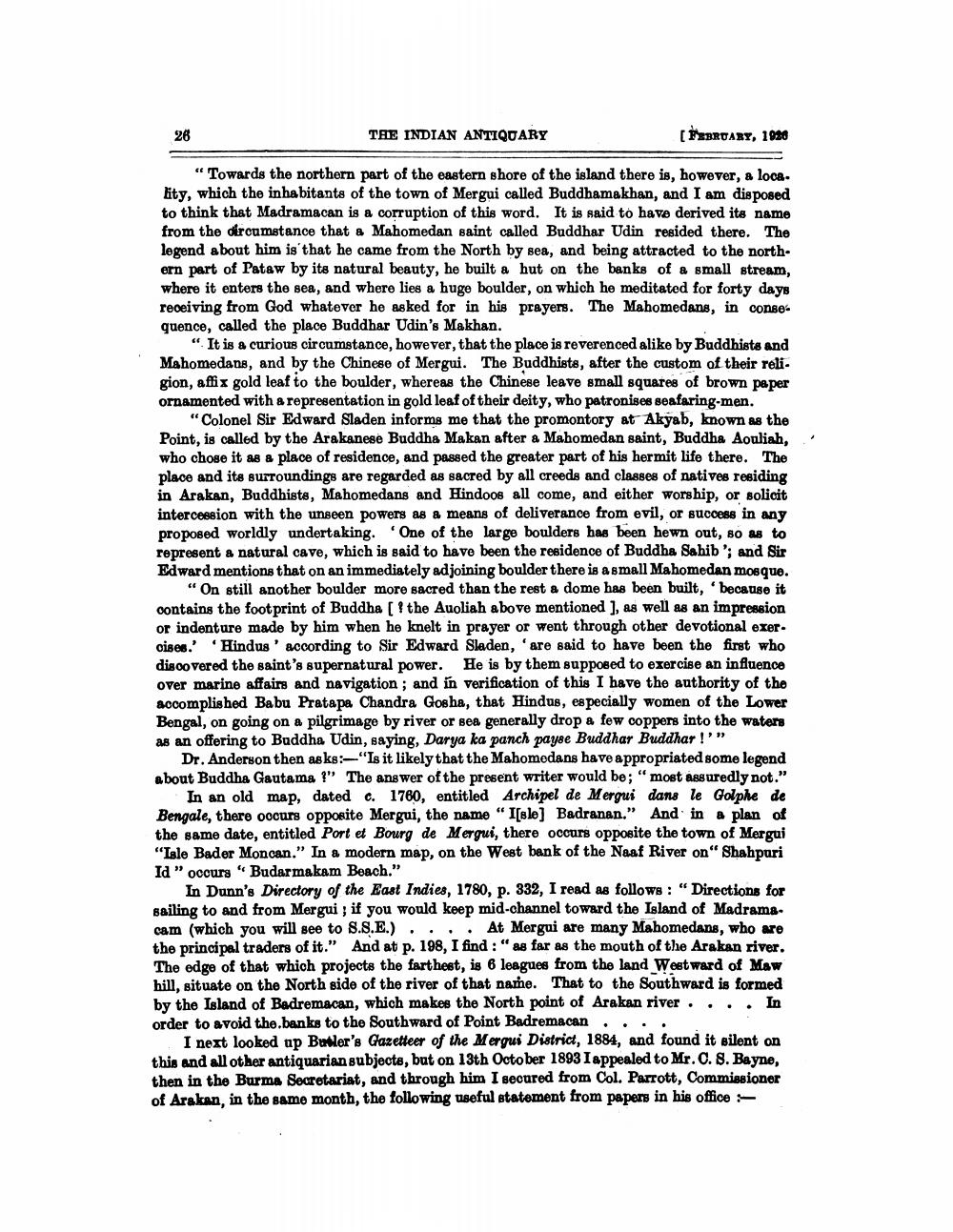________________
26
THE INDIAN ANTIQUARY
[ FEBRUARY, 1996
« Towards the northern part of the eastern shore of the island there is, however, a loca. lity, which the inhabitants of the town of Mergui called Buddhamakhan, and I am disposed to think that Madramacan is a corruption of this word. It is said to have derived its name from the dircumstance that a Mahomedan saint called Buddhar Udin resided there. The legend about him is that he came from the North by sea, and being attracted to the northern part of Pataw by its natural beauty, he built a hut on the banks of a small stream, where it enters the sea, and where lies a huge boulder, on which he meditated for forty days receiving from God whatever he asked for in his prayers. The Mahomedans, in congequence, called the place Buddhar Udin's Makhan.
"It is a curious circumstance, however, that the place is reverenced alike by Buddhists and Mahomedans, and by the Chinese of Mergui. The Buddhists, after the custom of their reli. gion, affix gold leaf to the boulder, whereas the Chinese leave small squares of brown paper ornamented with a representation in gold leaf of their deity, who patronises seafaring-men.
"Colonel Sir Edward Sladen informs me that the promontory at Akyab, known as the Point, is called by the Arakanese Buddha Makan after a Mahomedan saint, Buddha Aouliah, who chose it as a place of residence, and passed the greater part of his hermit life there. The place and its surroundings are regarded as sacred by all creeds and classes of natives residing in Arakan, Buddhists, Mahomedans and Hindoos all come, and either worship, or solicit intercession with the unseen powers as a means of deliverance from evil, or success in any proposed worldly undertaking. One of the large boulders has been hewn out, 80 as to represent a natural cave, which is said to have been the residence of Buddha Sahib'; and Sir Edward mentions that on an immediately adjoining boulder there is a small Mahomedan mosque.
“On still another boulder more sacred than the rest a dome has been built, because it contains the footprint of Buddha [ ? the Auoliah above mentioned ], as well as an impression or indenture made by him when he knelt in prayer or went through other devotional exer. oises.' 'Hindus' according to Sir Edward Sladen, are said to have been the first who discovered the saint's supernatural power. He is by them supposed to exercise an influence over marine affairs and navigation, and in verification of this I have the authority of the accomplished Babu Pratapa Chandra Gosha, that Hindus, especially women of the Lower Bengal, on going on a pilgrimage by river or sea generally drop a few coppers into the waters as an offering to Buddha Udin, saying, Darya ka panch payse Buddhar Buddhar!'"
Dr. Anderson then aske:"Is it likely that the Mahomodans have appropriated some legend abont Buddha Gautama ?" The answer of the present writer would be;"most assuredly not."
In an old map, dated c. 1760, entitled Archipel de Mergui dans le Golphe de Bengale, there oocurs opposite Mergui, the name " I[ele] Badranan." And in a plan of the same date, entitled Port et Bourg de Mergui, there occurs opposite the town of Mergui "Lale Bader Moncan." In a modern map, on the West bank of the Naaf River on" Shahpuri Id” occurs " Budarmakam Beach."
In Dunn's Directory of the East Indies, 1780, p. 332, I read as follows: "Directions for sailing to and from Mergui , if you would keep mid-channel toward the Island of Madrama. cam (which you will see to S.S.E.) .... At Mergui are many Mahomedans, who are the principal traders of it." And at p. 198, I find : " as far as the mouth of the Arakan river. The edge of that which projects the farthest, is 6 leagues from the land Westward of Maw hill, situate on the North side of the river of that name. That to the Southward is formed by the Island of Badremacan, which makes the North point of Arakan river...In order to avoid the banks to the Southward of Point Badremacan...
I next looked up Butler's Gazetteer of the Mergui District, 1884, and found it silent on this and all other antiquarian subjects, but on 13th October 1893 I appealed to Mr. C. 8. Bayne, then in the Burma Secretariat, and through him I secured from Col. Parrott, Commissioner of Arakan, in the same month, the following useful statement from papers in his office -




